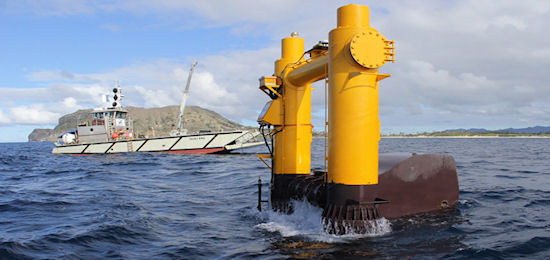Anyone who has played in the ocean surf or experienced the current of a river, felt the tug of outgoing or incoming surf, recognizes that there is energy contained in moving bodies of water.
Harnessing that energy to create electricity has been in third position, behind solar and wind, as a source of alternative energy. But now, advances in technology are changing that situation. Commercially viable prototypes and active production models operating in wave farms are currently producing electricity successfully. The World Energy Council has described wave energy as a concentrated form of solar energy. With three quarters of the earth covered in water, wave power is an inexhaustible source of clean energy.
Wave power- a brief history
- Wave Power has been used as early in human history as 1100 AD in Egypt and, what is now, France and Russia. Wave power during this period was used to mill grain.
- One of the earliest known patents was registered to a Frenchman named Girard in Paris and was dated 1799. Interest waned, as it did for wind, during the Industrial Age when fossil fuel became cheap, easy to find and more efficient to use.
- In 1909, the then California Wave Power Company created electricity that was used to provide electricity to the wharves in California.
- Yoshio Masuda, in 1940, used wave power to light navigation lights.
- Interest in wave power strengthened in 1973, when the Arab nations invoked an embargo on the export of oil.
Universities around the world embarked on research to harness the power of the wave at such institutes as MIT and the US Naval Academy in this country. As a side note, the US Navy is currently heavily involved in the use of green sources of energy and is pushing away from a dependence on foreign oil supplies. In other countries, those involved in wave power technology were the University of Edinburgh and Norwegian University of Science and Technology. After the oil began to flow again, research slowed. Leading the way in research today is the University of Oregon, which has partnered on several installations along the Oregon coast.
Now with increases in fossil fuel costs and concern about the effects on the environment of global climate change, advances in wave power technology to create energy are full steam ahead.
Waves- how are they formed
As the sun heats the surface of the earth it creates uneven heating, which, in conjunction with the earth’s rotation, creates wind. Waves are formed by wind passing over the surface of water. As energy is transferred to the water it forms ripples, then, as the force of the wind continues to release energy on the surface, the water forms waves. If this process continues over an extended length of the water’s surface, ocean swells are formed. These ocean swells can travel great distances without a substantial loss of energy.
The World Energy Council estimates that the energy produced by the power of the earth’s ocean waves would produce two times the amount of electricity that is currently created by all other sources of electrical production, including coal and natural gas. This would be done without the hazardous emissions generated by coal and natural gas fired plants. For a more complete list of pollutants and the effects of mining for coal see Energy Loft
Wave Power- The technology
A number of companies have entered the wave power generation field. Some are funded by private infusion and businesses themselves. Others are supplemented by grants or incentives from governmental entities. The countries of Portugal, Scotland, Spain and Australia are investing heavily in this technology.
Ocean Powered Technology (OPT) is headquartered in Pennington New Jersey. OPT’s “PowerBouy” has been deployed commercially in six locations: Atlantic City, NJ, Oahu, Hawaii, Santona, Spain, Hayle, England, Reedsport, Oregon and Cross Bay ,Oregon.
In Oahu, OPT is working with the US Navy and Marines at the Marine base supplying electricity from the offshore PowerBouy array.
As you can see by the photographs, the bulk of the “PowerBouy” is located under the surface of the ocean and, with its design; it can be used to mount navigation signals. Communication devices and monitoring equipment can also be mounted on the buoy. They have designed their trademarked “Talk on Water” that allows boaters to use cell phones offshore, a great benefit for boaters if an emergency arises.
Voith Hydro Wavegen Limited is headquartered in Germany with offices and manufacturing facilities in Inverness, Scotland on the North Sea. In Islay, Scotland, Voith Hydro has a tide turbine generator built on the shoreline that looks like a concrete bunker.
Their offshore tidal current turbine looks like a wind turbine, but this one is underwater, as can be seen on this video produced by Voith Hydro. The blades are approximately 26 feet in diameter and seven stories high.
Pelamis Wave Power Ltd.is headquartered in Edinburgh Scotland. Their Pelamis Wave Energy Converter has the appearance of a segmented snake that is partially submerged when deployed. The joints incorporate hydraulic rams which pump the high-pressure fluid through motors when the wave passes along the unit.
Pelamis units are used at the first commercial wave farm at Agucadoura, Portugal and a phase of the project is planned for the near future
There are undoubtedly numerous other companies and designs, but these are fine examples of the work that is being done in the wave power generation field.




